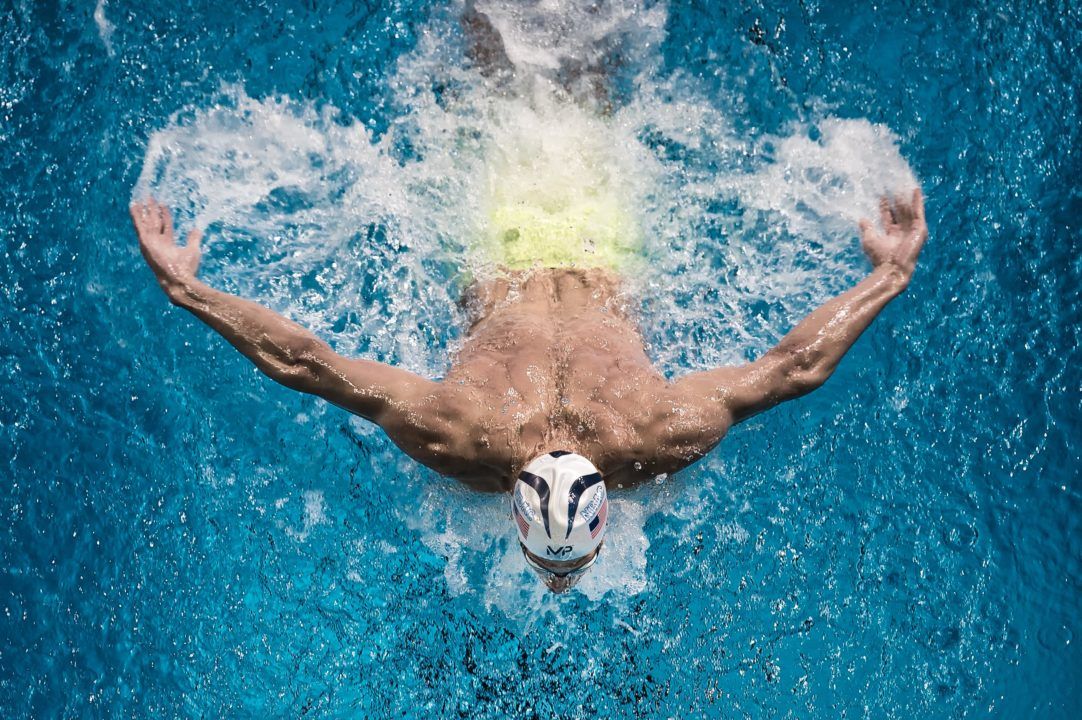Courtesy of Gary Hall Sr., 10-time World Record Holder, 3-time Olympian, 1976 Olympic Games US Flagbearer and The Race Club co-founder.
Butterfly is a challenging stroke. It is the most difficult to perform and sustain over any moderate distance. The reason is that it doesn’t conform well to the law of inertia, and, therefore, requires more energy. Nearly all of the propulsion in butterfly comes at two key points in the stroke cycle coinciding with the down kicks. The first down kick occurs as the hands are pushing backward under the body, somewhere toward the end of the pull. The second down kick should be timed to coincide with the entry of the recovering arms into the water.
In between these two points of acceleration is lots of down time, where there is little or no propulsion and the velocity of the body slows down. As a result, the swimmer has to work harder to get the velocity back up, leading to less efficiency than in freestyle or backstroke, for example.
Here are three key techniques for developing a faster butterfly.
1. Develop a stronger kick
Butterfly, along with breaststroke, is a very kick-dependent stroke. Without a strong kick, butterfly simply doesn’t work well. While the two down kicks in each stroke cycle need to be strong, the up kicks are also important in order to maintain a higher velocity. The strength of the down kick, without causing excessive frontal drag, is dependent on having extreme ‘pigeon- toed’ plantar flexibility, and not overbending the knees (around 60 degrees). It also requires much strength and stamina in the quadriceps femoris muscles. A strong up kick depends on flexing the hip to around 30 degrees, having plantar flexibility, and having strong lower back, hamstring, and calf muscles.
2. Don’t over-elevate the shoulders for the breath
With a front breath, it is very common to see swimmers elevate the shoulders higher out of the water than is really necessary. While higher elevation of the body increases the coupling energy for the second down kick, it also causes a lot more frontal drag. The trade-off is not worth it.
The loss of velocity caused by the more vertical position of the body is too hard to overcome. Some elevation of the shoulders is absolutely necessary in order to breathe and recover the arms, but keep it minimal by extending the neck forward with the mouth barely above the surface for the breath.
3. Emphasize the two coupling motions
There are two powerful coupling motions available in butterfly to use to increase the propulsion from the second down kick. One is the arm recovery and the second is the downward motion of the head (and upper body). By straightening and accentuating the speed of the recovering arms, the kinetic energy of this motion increases dramatically. By delaying the head snapping down after the breath to coincide with the entry of the hands into the water, this approximately 12 pounds of mass can also help strengthen the second down kick. The result of using both of these well-timed coupling motions together is a huge surge of velocity from the second down kick that often exceeds the velocity achieved from the first kick and pull together. That is power!
Over the next few weeks, you will find some excellent videos in Lanes 2, 3 and 4 on our website highlighting the classroom, techniques, and technology for a better butterfly. We hope you will hop on in!
Yours in Swimming, Gary Sr.
Like The Race Club on Facebook
Follow The Race Club on Instagram
Follow The Race Club on Twitter
Connect to The Race Club / Gary Hall Sr. on Linkedin
[email protected]
See The Race Club HQ here.
THE RACE CLUB
 Because Life is Worth Swimming, our mission is to promote swimming through sport, lifelong enjoyment, and good health benefits. Our objective is for each member of and each participant in The Race Club to improve his or her swimming performances, health, and self-esteem through our educational programs, services and creativity. We strive to help each member of The Race Club overcome challenges and reach his or her individual life goals.
Because Life is Worth Swimming, our mission is to promote swimming through sport, lifelong enjoyment, and good health benefits. Our objective is for each member of and each participant in The Race Club to improve his or her swimming performances, health, and self-esteem through our educational programs, services and creativity. We strive to help each member of The Race Club overcome challenges and reach his or her individual life goals.
The Race Club provides facilities, coaching, training, technical instruction, video, fitness and health programs for swimmers of all ages and abilities. Race Club swim camps are designed and tailored to satisfy each swimmer’s needs, whether one is trying to reach the Olympic Games or simply improve one’s fitness. Our programs are suitable for beginner swimmers, pleasure swimmers, fitness swimmers, USA swimming or YMCA swimmers, or triathletes; anyone who wants to improve swimming skills. All of our Race Club members share an enjoyment of being in the water and use swimming to stimulate a more active mind and body.
Courtesy of The Race Club, a SwimSwam partner.


Hi, my name is Emma Waters. I am a freshman at the Durango High School Swim team. I have been swimming 500’s free lately and in my last one, I cut 8 seconds. It was amazing to be able to read all this important info mention. Thank you so much!
Hello,
I am a swimmer for the Sarasota Sharks. Thank you very much for the tips you have on your website. I have a meet coming up this week and I have been reading the stuff you are posting. They give me hope that I will make an 11 year old FLAG cut. Again thank you very much.